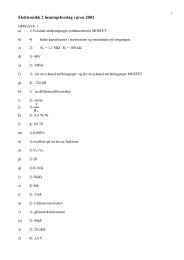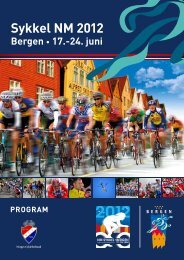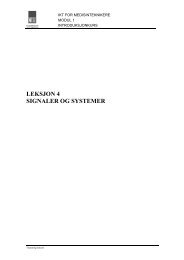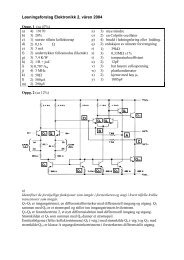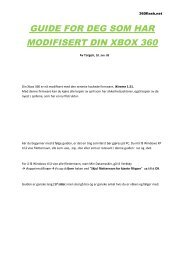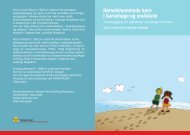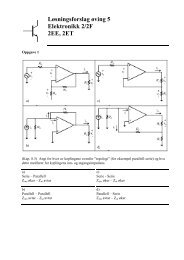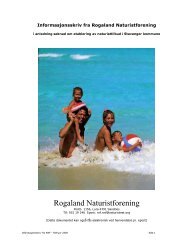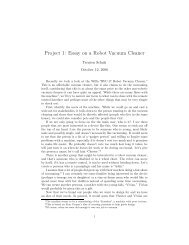The Online World resources handbook
The Online World resources handbook
The Online World resources handbook
You also want an ePaper? Increase the reach of your titles
YUMPU automatically turns print PDFs into web optimized ePapers that Google loves.
Electronic mail, telex, and fax http://home.eunet.no/~presno/bok/7.html<br />
When people talk about this phenomenon, they often refer to it as "Internet mail,"<br />
even if they are just using the Internet as kind of a telephone exchange.<br />
Let us take a closer look at the art of addressing mail through the Internet and the<br />
Matrix.<br />
Finding a friend's email address<br />
<strong>The</strong> best method of finding a friend's email address is usually to call your friend and ask.<br />
Many people have several mailboxes. Only by asking will you find out which mailbox is<br />
being used!<br />
So, you don't know the telephone number? Try http://www.contractjobs.com/tel/.<br />
This site offers links to online telephone, fax, and business directories around the world.<br />
Sometimes, the information provided by a recipient is not enough. Maybe the<br />
address needs an extension for mail to be routed through gateways to the destination?<br />
Typically, the syntax of the address is wrong. Perhaps you made a mistake, when<br />
you wrote it down (KIDCAFE TOPICS became KIDSCAFE TOPICS).<br />
<strong>The</strong> return address in the received messages' mailer headers may be wrong. Yes,<br />
this happens surprisingly often. It may use a syntax that is illegal on your email system,<br />
or suggest a routing that is unknown to your system. When trying to send a reply to this<br />
address, the Mailer Daemon complains: "This is a non existent address."<br />
Again, the first person to contact for help is your local postmaster. On many<br />
Internet hosts, this is simple. If you have a mailbox on the ULRIK computer at the<br />
University of Oslo, send your request to postmaster@ulrik.uio.no . If you are on<br />
COLNET in Buenos Aires, send to postmaster@colnetr.edu.ar .<br />
POSTMASTER is also the address to turn to on BITNET. Users of FidoNet or<br />
RelayNet, write to SYSOP.<br />
<strong>The</strong>re are hundreds of "whois servers" around the world. <strong>The</strong> systems<br />
whois.nic.ad.jp and whois.ripe.net cover Japan and Europe. Others provide information<br />
about local users. (For a list, see ftp://sipb.mit.edu/pub/whois/whois servers.list.)<br />
Note: You need to know the exact address of your recipient, and whether he is<br />
using this mailbox regularly. Many users have mailboxes that they use rarely or<br />
never. $OVR WKLQN RI WKH HDVLHVW ZD\ IRU D UHFLSLHQW WR UHVSRQG EHIRUH VHQGLQJ D PHVVDJH<br />
to him or her.<br />
Directories of subscribers and services<br />
While many hosts let you search lists of local users, no complete global directory of<br />
available electronic addresses exists!<br />
Several services on the Internet offer help. My favorite is the Usenet address<br />
database ,W LV DOVR DFFHVVLEOH E\ HPDLO WR mail server@rtfm.mit.edu. To query, put the<br />
following in the body of your text:<br />
send usenet addresses/[name searching for]<br />
<strong>The</strong> "name" should be one or more space separated words for which you want to search.<br />
Since the search is "fuzzy" (that is, all the words you specify do not have to match), you<br />
should list all words you think might appear in the address, including first and last name,<br />
possible username, and possible parts of the host name. <strong>The</strong> case and order of the words<br />
you list are ignored. (Send the command "send usenet addresses/help" to this address for<br />
more information.) Example:<br />
send usenet addresses/odd de presno<br />
X.400 systems use an address directory according to ITU TSS standard X.500 that<br />
connect several directories. <strong>The</strong> developers hoped that routing of X.400 messages may<br />
eventually be done automatically without the user needing to know the identity of the<br />
recipient's mailbox computer. However, it never became a big success.<br />
<strong>The</strong> Lightweight Directory Access Protocol (LDAP) was introduced as an<br />
alternative to X.500 to become "the comprehensive Internet wide e mail address<br />
directories of the future". It is a subset of the Directory Access Protocol (DAP) used to<br />
4 of 20 23.11.2009 15:45



